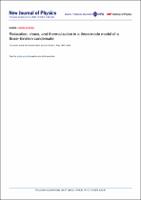Please use this identifier to cite or link to this item:
https://hdl.handle.net/20.500.12202/4295Full metadata record
| DC Field | Value | Language |
|---|---|---|
| dc.contributor.author | Garcia-March, M.A. | - |
| dc.contributor.author | van Frank, S. | - |
| dc.contributor.author | Bonneau, M. | - |
| dc.contributor.author | Schmiedmayer, J. | - |
| dc.contributor.author | Lewenstein, M. | - |
| dc.contributor.author | Santos, Lea F. | - |
| dc.date.accessioned | 2018-12-31T20:52:44Z | - |
| dc.date.available | 2018-12-31T20:52:44Z | - |
| dc.date.issued | 2018-11-27 | - |
| dc.identifier.citation | Garcia-March, M.A., van Frank, S., Bonneau, M., Schmiedmayer, J., Lewenstein, M. and Santos, L.F. (2018). Relaxation, chaos, and thermalization in a three-mode model of a Bose–Einstein condensate. New Journal of Physics 20: 113039. | en_US |
| dc.identifier.issn | 1367-2630 | - |
| dc.identifier.uri | https://doi.org /10.1088/1367-2630/aaed68 | en_US |
| dc.identifier.uri | https://hdl.handle.net/20.500.12202/4295 | - |
| dc.description.abstract | We study the complex quantum dynamics of a system of many interacting atoms in an elongated an harmonic trap. The system is initially in a Bose–Einstein condensed state, well described by Thomas–Fermi profile in the elongated direction and the ground state in the transverse directions. After a sudden quench to a coherent superposition of the ground and lowest energy transverse modes, quantum dynamics starts.We describe this process employing a three-mode many-body model. The experimental realization of this system displays decaying oscillations of the atomic density distribution. While a mean-field description predicts perpetual oscillations of the atomic density distribution, our quantum many-body model exhibits a decay of the oscillations for sufficiently strong atomic interactions.We associate this decay with the fragmentation of the condensate during the evolution. The decay and fragmentation are also linked with the approach of the many-body model to the chaotic regime. The approach to chaos lifts degeneracies and increases the complexity of the eigenstates, enabling the relaxation to equilibrium and the onset of thermalization.We verify that the damping time and quantum signatures of chaos show similar dependences on the interaction strength and on the number of atoms. | en_US |
| dc.description.sponsorship | We thank encouraging and fruitful discussions with B Julia-Diaz, T Berrada, CGogolin, P Grzybowski and J F Schaft. We acknowledge the Spanish Ministry MINECO (National Plan 15 Grant: FISICATEAMO No. FIS2016- 79508-P, SEVEROOCHOA No. SEV-2015-0522, FPI), European Social Fund, Fundació Cellex, Generalitat de Catalunya (AGAUR Grant No. 2017 SGR 1341 and CERCA/Program), ERC AdG OSYRIS, ERC advanced Grant QuantumRelax, EU FETPRO QUIC, and the National Science Centre, Poland-Symfonia Grant No. 2016/20/ W/ST4/00314.MB was supported by the EU through the Marie Sklodowska Curie grant ETAB (ga no.656530) and by the FWF through the Lise Meitner grant CoPaNeq (M2088-M27). LFS was supported by the NSF Grant No. DMR-1603418. | en_US |
| dc.language.iso | en_US | en_US |
| dc.publisher | IOP Publishing | en_US |
| dc.relation.ispartofseries | New Journal of Physics;20 | - |
| dc.rights | Attribution-NonCommercial-NoDerivs 3.0 United States | * |
| dc.rights.uri | http://creativecommons.org/licenses/by-nc-nd/3.0/us/ | * |
| dc.subject | thermalization | en_US |
| dc.subject | relaxation in isolated quantum systems | en_US |
| dc.subject | quantum chaos | en_US |
| dc.subject | Bose-Einstein condensates | en_US |
| dc.title | Relaxation, chaos, and thermalization in a three-mode model of a Bose–Einstein condensate. | en_US |
| dc.type | Article | en_US |
| dc.contributor.orcid | 0000-0001-9400-2709 | |
| local.yu.facultypage | https://www.yu.edu/faculty/pages/santos-lea | |
| Appears in Collections: | Stern College for Women -- Faculty Publications | |
Files in This Item:
| File | Description | Size | Format | |
|---|---|---|---|---|
| Santos Relaxation Garcia-March_2018_New_J._Phys._20_113039.pdf | OA | 1.75 MB | Adobe PDF |  View/Open |
This item is licensed under a Creative Commons License

